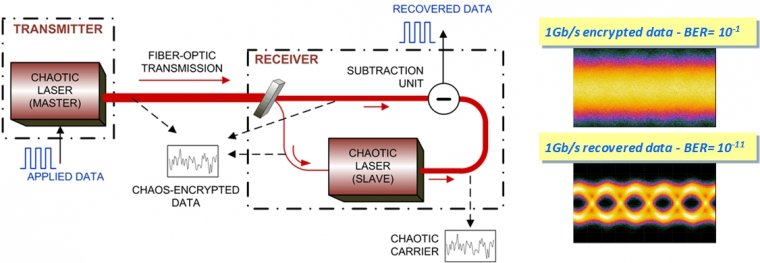1.2 Secure communication systems
Chaotic signals have been proposed as broadband information carriers with the potential of providing a high level of robustness and privacy in data transmission in the physical layer. In the conventional communications systems an optical oscillator (based on a semiconductor laser), generates a coherent optical carrier on which the information is encoded using one of the many available modulation schemes. On the contrary, in the proposed approach the transmitter consists of an optical oscillator forced to operate at the chaotic regime by an external feedback, producing thus an optical carrier with extremely broadened spectrum (in the order on many tens of GHz). The information (typically an OOK bit stream) is encoded on this chaotic carrier using different techniques (e.g. a simple yet efficient method is to use an external optical modulator electrically driven by the information bit stream while at its input is coupled the optical chaotic carrier). It is practically impossible to extract this encoded information using conventional techniques like linear filtering, frequency domain analysis or phase space reconstruction, assuming a high complexity in signal carrier and message amplitude that does not exceed a few percent of the amplitude of the chaotic carrier. At the receiver side of the system a second chaotic oscillator is used, as "similar" as possible to that of the transmitter. This "similarity" refers to:
- Semiconductor laser structural, emission (emitting wavelength, slope efficiency, current threshold, etc.) and intrinsic parameters (linewidth enhancement factor, non-linear gain, photon lifetime, etc.)
- Feedback loop characteristics (cavity length, cavity losses, possible non-linearity, etc.)
- Operating parameters (bias currents, feedback strength, etc.)
The above set of hardware-related parameters constitutes the key of the encryption procedure.
Laboratory demonstrations of chaos-based optical communications have already shown the potential of this technology. In Optical Communications Laboratory, for the very first time, high-speed long-distance communication based on chaos data encryption over a commercial installed fiber-optic channel has been demonstrated. A chaotic optical carrier generated by semiconductor lasers with optical feedback or by photonic integrated circuits has been used to encode a message for transmission over 120 km of optical fiber in the metropolitan area network of Athens, Greece. The message is decoded using an appropriate chaotic receiver which, by synchronizing with the chaotic carrier, allows for the separation of the carrier and the message. Transmission rates in the gigabit per second range have been achieved, with corresponding bit-error rates as low as 10^(-11). The system used matched pairs of chaotic emitters and receivers and off-the-shelf fiber-optic telecommunication components. Our results show that information can be transmitted at high bit rates using deterministic chaos in a manner that is robust to perturbations and channel disturbances unavoidable under real-world conditions.
Related projects:
- OCCULT
- PICASSO
Significant publications:
- A. Argyris, D. Syvridis, L. Larger, V. Annovazzi-Lodi, P. Colet, I. Fischer, J. Garcia-Ojalvo, C.R. Mirasso, L. Pesquera and K.A. Shore, “Chaos-based communications at high bit rates using commercial fibre-optic links”, Nature, vol. 438, n. 7066, pp. 343-346, November 2005.
- D. Syvridis, A. Argyris, A. Bogris, M. Hamacher and I. Giles, "Integrated devices for optical chaos generation and communication applications", IEEE Journal of Quantum Electronics, vol. 45, n. 11, pp. 1421-1428, November 2009.
- A. Argyris, E. Grivas, M. Hamacher, A. Bogris and D. Syvridis, "Chaos-on-a-chip secures data transmission in optical fiber links", Optics Express, vol. 18, n. 5, pp. 5188-5198, March 2010.
- A. Argyris, E. Grivas, A. Bogris and D. Syvridis, "Transmission Effects in Wavelength Division Multiplexed Chaotic Optical Communication Systems", IEEE Journal of Lightwave Technology, vol. 28, n. 21, pp. 3107-3114, November 2010.

